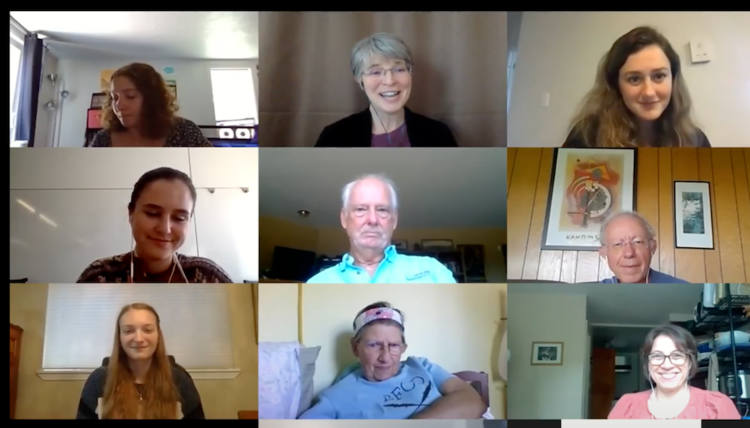Undergraduate Gonzaga Symposium With The Beckstead Lab Goes Virtual
.ashx?rev=5927241d271e4d6a9317ddf552155414)
So many things fell into limbo with the shift to online classes. In response to undergraduate research conference cancelations, Dr. Julie Beckstead Lab at Gonzaga University hosted a virtual symposium that provided student researchers the opportunity to share and celebrate their Summer 2020 achievements. In-person conferences offered many opportunities for burgeoning researchers to connect with scientists and scientists. Instead of forgoing the chance to continue this networking style, Dr. Beckstead opted for a virtual option to keep the conversation going.
We reached out to a few student researchers who participated in the Symposium, Hayley Brandecker, Jessica Lubisich, and Holly Fahning, to learn more about their research experience and the symposium.
Researchers Jessica Lubisich, Hayley Brandecker, and Holly Fahning.
First off, what degree are you pursuing at Gonzaga?
Hayley: I'm pursuing a degree in biology with a research concentration.
Jessica: I am pursuing a B.S. in Biology and a research concentration with minors in Philosophy and Chemistry.
Holly: I am pursuing a B.S. in biology with a research concentration and minors in Chemistry and Environmental Studies.
What research did you undertake and present at the symposium?
Hayley: My research topic for the symposium was identifying which native seed species can germinate and establish the following heat treatments associated with fires. I found some of the unexpected things during my research was how one species did better with rising heat temperatures while the other reacted oppositely and germinated worse as the temperature increased.
Jessica: I presented the effects of Morchella, a morel fungus, on native plant germination during restoration. I investigated how contamination with ash, fungus, or both impacted the germination of a native grass.
Holly: My research topic for the symposium was mucilaginous and fungal partner impacts on native grass germination in a post-fire environment. This topic came about by thinking about ways to help native seeds/seedlings in a restoration setting. What advantages could we give to native seeds that would potentially allow them to germinate faster or develop longer roots in a competitive environment, potentially with invasive species as well? This led me to have the treatments of applying chia seeds as a mucilaginous partner for the native seeds and a potential fungal mutualist to the seeds.
"…That is one of the beauties of science, it is the exploration of the unknown and what that new knowledge might mean for the world around us."
Did you discover anything novel or unexpected during your research?
Hayley: Some of the unexpected things I found during my research were how one species did better with rising heat temperatures. The other reacted oppositely and germinated worse as the temperature increased.
Jessica: I found that my fungal treatments significantly increased overall germination rate and decreased days until 50% germination. These are both useful findings when considering fungus as a tool to help promote native plant restoration.
Holly: My treatments of the mucilaginous and fungal partners did not positively affect the germination rate or root length. The Ash treatment had the most effect in my experiment with germinating seeds with ash having significantly shorter roots than those without ash.

Participants at the virtual Beckstead Symposium.
How was it conducting your work during quarantine?
Hayley: It was a little tricky at first, but as the weeks went on, it was super interesting to see all we could accomplish from home. We had to adapt our ideas and procedures, but it was super helpful to have Dr. Beckstead and the other research students collaboration.
Jessica: The research flow during quarantine was quite different since I did not have immediate access to my lab mates or research mentor. Although, I was able to meet with all lab members regularly through zoom or phone calls. During home research, I had to be much more independent and creative since I did not have regular lab tools. As a team, we came up with unique tools and techniques which were more practical for use outside the lab. I have always been told that you do not need a fancy laboratory and tools to conduct meaningful research. This summer, our team proved that! I was working in a manner that I had never expected, but I believe that this experience has helped me grow as a researcher.
Holly: Researching during quarantine and at home was a very different experience than my on-campus one last summer. We had to be more creative with our experimental design to include easily accessible products and perform our experiments and experimental treatments without the lab equipment that we might typically have access to. It was a good experience, and I worked on self-motivation and online communication skills. I was also thrilled to have a remote work opportunity this summer as all the other internships I had applied for were canceled. Dr. Beckstead worked very hard this summer to help us with our projects and even added extra students to our lab because she was one of only a few professors doing remote research.
As a way to inspire her students in what has been less than ideal circumstances, Professor Beckstead the following message shortly after the pandemic became a reality, "…That is one of the beauties of science, it is the exploration of the unknown and what that new knowledge might mean for the world around us. COVID-19 is altering our lives and seems to have taken control, but it does not interfere with the curiosity of science."

